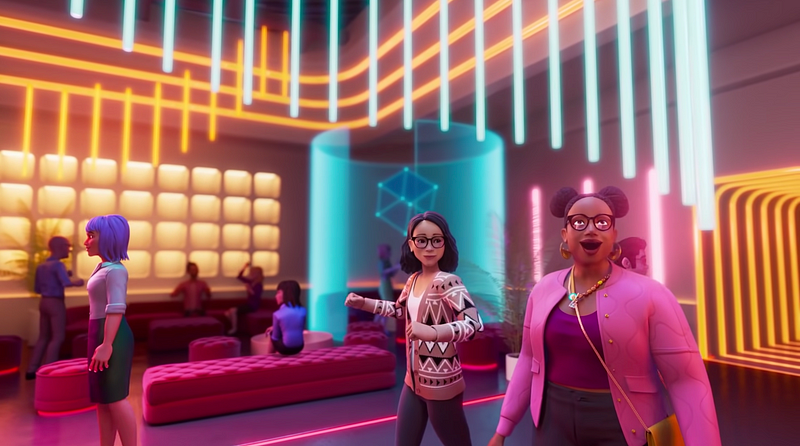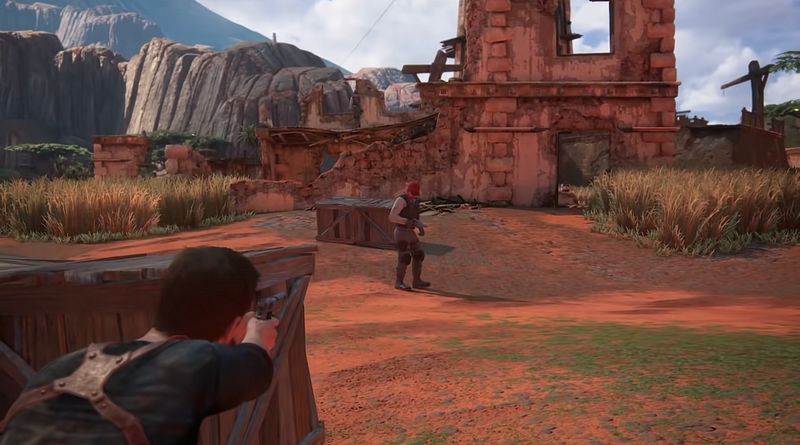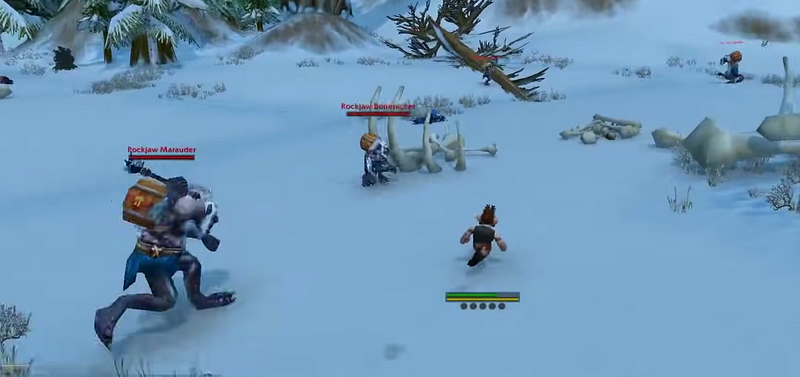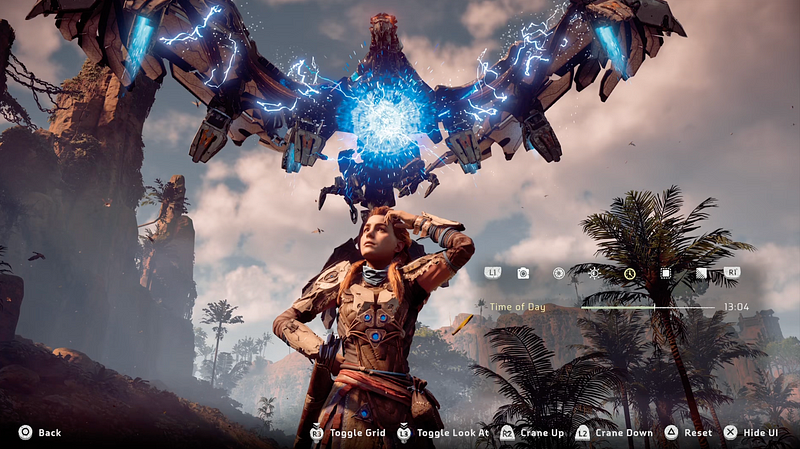Is it possible to design a nonviolent metaverse based off open-world combat games?
It’s one thing to build a virtual world; it’s another to give a user a set of intuitive tools that will let them explore it in full. So far, many forays into metaverse interfaces follow the example set by video games. Fortnite demonstrates this quite literally, as it is attempting to expand beyond its battle royale mode into general entertainment with a template made for combat. The recent demos which Facebook — sorry, Meta — has released for its planned metaverse also make the experience resemble playing a MMORPG, but to perform everyday functions, such as with school and work.
 A
conceptual preview of an entertainment space within the metaverse of Meta (formerly Facebook, Inc).
From “The Metaverse and How We’ll Build It
Together” by Meta
A
conceptual preview of an entertainment space within the metaverse of Meta (formerly Facebook, Inc).
From “The Metaverse and How We’ll Build It
Together” by MetaIt makes sense that Meta’s designers would look to the now well-established parameters around navigating an avatar through a constructed world. But there’s one glaring issue with following that standard: Many of the verbs for interaction in the open-world and online games from which metaverse designers are taking their cues are structured primarily around violence. And the problems some games have had with breaking out of this format forebode similar problems for the metaverse.
There are, of course, plenty of popular games that aren’t built around killing. But by and large, they are not the games the metaverse is trying to imitate. The people behind Meta don’t look to mobile puzzle games for inspiration, for example. Even life sims like Animal Crossing don’t seem to have much of an influence (even though the modes of social interaction that series has engendered could arguably provide a helpful example for metaverse creators to look to). Based on the glossy graphics of Meta’s demos and the wider cultural emphasis on VR and AR, a top priority for these experiences is immersion. And that means the cutesy, top-down dollhouse look of Animal Crossing won’t do. Metaverse makers are looking to the open world. And most of the games with open-world or otherwise immersive experiences have built them as playgrounds for violence.
 Crates in
Uncharted: A Thief’s End are arranged in such a way that only make sense if they
are meant to be hidden behind during gunfights. Still from “Games, Schools, and Worlds Designed for
Violence” by Jacob
Geller
Crates in
Uncharted: A Thief’s End are arranged in such a way that only make sense if they
are meant to be hidden behind during gunfights. Still from “Games, Schools, and Worlds Designed for
Violence” by Jacob
GellerThis paradigm already poses ludo-design issues. As video essayist Jacob Geller points out, crafting game experiences primarily around combat often results in environments that push or outright break the bounds of verisimilitude. Hence the Uncharted series is full of crates stacked and spread out in configurations that only make sense as playgrounds for gunfights, and Gears of War games are labyrinthed with a truly ludicrous number of waist-high barriers. With each successive generation of gaming hardware, advancements have often prized “realism” above all else — more lifelike graphics, more levels of interaction between player and world. While designers have gotten better at hiding the seams in level design or the invisible walls that herd a player along their designated path, they often still struggle with making it feel as though these stories take place in lived-in worlds, rather than in spaces designed entirely for the player.
Within AAA gaming, attempts at crafting nonviolent experiences often live alongside the default of violence. Take any role-playing game — Fallout, Dragon Age, Mass Effect, etc. — in which fights can sometimes be avoided through the proper use of dialogue. Some have admirably complex text trees that can make talking one’s way out of a confrontation just as challenging and satisfying as fighting it out. Yet a failure of dialogue will simply cause the scenario to revert to punching or shooting. Rare is the sequence in which one has to solve things nonviolently.
 Showing off
a “non-lethal assault rifle” (not an oxymoron in this sci-fi universe) in “Death Stranding.” Still
from “DEATH STRANDING — Assault Rifle (Lv. 2)
— Non-Lethal Assault Rifle (Lv. 2) Design Data” by Huester 101
Showing off
a “non-lethal assault rifle” (not an oxymoron in this sci-fi universe) in “Death Stranding.” Still
from “DEATH STRANDING — Assault Rifle (Lv. 2)
— Non-Lethal Assault Rifle (Lv. 2) Design Data” by Huester 101Popular director Hideo Kojima has done more work than many to make nonviolent approaches just as robust systems of interaction as violent ones in his games, primarily the Metal Gear Solid series. His stories try to emphasize the moral weight of killing. In Metal Gear Solid 3: Snake Eater, one late-game sequence will confront the player with the ghost of every single person they’ve killed. Yet the nonviolent systems these games present are often simple substitutions — tranquilizer guns instead of lethal ones, for instance. This is especially blatant in Kojima’s most recent title, 2019’s Death Stranding. An anti-killing ethos is built into the very concept of the story. Dead human bodies will rapidly cause a cataclysmic rift in space-time, and so if you kill anyone in the game it will forever taint a small region of the map. Yet the many non-lethal possibilities for play (crafting stun bombs, bolos, even machine guns that fire rubber bullets) are still quite brutal, and look and feel almost exactly like the “real” alternatives. I winced when I accidentally ran down an enemy with a truck, only to discover that the game was pretty forgiving in the amount of bodily harm I could dish out; I guess that poor sap “only” ended up in traction.
 “Well, this
is gonna be Raandyy’s first death, I think.” Still from “Griffin’s MURDER-FREE Tour of World of
Warcraft — PeaceCraft Ep. 1” by Polygon
“Well, this
is gonna be Raandyy’s first death, I think.” Still from “Griffin’s MURDER-FREE Tour of World of
Warcraft — PeaceCraft Ep. 1” by PolygonMany commentators have played with the absurdity of these situations through comedic creations. “Peacecraft,” a YouTube series by Polygon co-founder and popular podcaster Griffin McElroy, follows his attempt to navigate World of Warcraft without engaging in any combat. The premise gets more challenging (and funnier) as he ventures into areas of the game with higher-leveled monsters and hostile players. What do you get out of WoW if you aren’t grinding for experience points? Within the parameters of the game’s raiding mission loop, many players have forged complex and meaningful social interactions. But McElroy’s antics demonstrate how difficult it can be to do things as basic as leveling up and earning money without fighting.
 Still from
“Celebrate MLK: TIME Studios Presents March
Through Time in Fortnite” by PlayStation
Still from
“Celebrate MLK: TIME Studios Presents March
Through Time in Fortnite” by PlayStationFortnite, the current titan of online shooters, has run into a similar issue with its attempts to become an all-purpose entertainment platform. This has worked somewhat with its incorporation of concerts (at least during the lengthy COVID-19 quarantine), but the custom-built “entertainment experiences” are having trouble catching on. Look no further than the woefully misguided “March Through Time” event, which let players explore a replica of the National Mall during the 1963 March on Washington. There’s a lot of theoretical possibilities in crafting educational immersive experiences, but the run-and-gun control scheme of Fortnite was a poor fit for it. Users would awkwardly stand around and watch videos of Martin Luther King Jr.’s speech, pursue overly literal actions in tribute to his words (such as climbing to an actual in-game mountaintop), or perform grossly inappropriate emotes.
In contrast, a highly violent franchise pulled off a similar idea much more successfully with comparatively little effort. Recent entries in the Assassin’s Creed series, each of which recreates a specific historical milieu (Ptolemaic Egypt, Viking-age Scandinavia, etc.) have incorporated a “Discovery Mode.” In this feature, combat is deactivated, and a player can simply explore the meticulous renderings of these places. In doing so, the developers inadvertently spotlight how often a focus on violence can obscure the vast amount of work they put into building these environments.
 A tour of
the Great Pyramids in the Discovery Mode for “Assassin’s Creed: Odyssey.” Still from “Assassin’s Creed Origins Discovery Mode:
Complete Tour of the Pyramids” by IGN
A tour of
the Great Pyramids in the Discovery Mode for “Assassin’s Creed: Odyssey.” Still from “Assassin’s Creed Origins Discovery Mode:
Complete Tour of the Pyramids” by IGNWhile publishers’ attempts to retrofit their tools for educational ends often come up short, outsiders can subvert these tools for much greater educational effect. Academics and experimenters have found their own ways of drawing out the contradictions of spaces designed for violence. Grayson Earle examines how the fact that Grand Theft Auto’s police NPCs will never fight each other, no matter how one tinkers with the code, unwittingly demonstrates the real-world “blue wall of silence” and inter-cop solidarity. Similarly, the “pseudo-Marxist media guerrilla” collective Total Refusal uses various AAA titles as spaces from which to perform lectures on contemporary issues. They’ve mastered an impressive level of cooperation to organically tour these games, often while networked and in PvP mode, while speaking to an audience. It’s like a Let’s Play video crossed with a conference talk. Operation Jane Walk uses Tom Clancy’s The Division to look at urban architecture and design. How to Disappear is an antiwar movie that plays out within Battlefield V, testing how far a player can “desert” a firefight within its maps while illuminating the history of desertion in warfare.
There is one nonviolent aspect that AAA games pull off with relative ease. At this point it is almost de rigueur for games, especially open-world titles, to include some kind of photo mode. It doesn’t take much programming effort to swap out one definition of the word “shoot” for another, and it dovetails nicely both with designers’ desire to show off the intricate spaces they’ve created and with players’ desire to share their experiences on social media. Certain games will even let your player character pose for the pictures you take, breaching the fourth wall but making for a memorable image. Some titles even have a diegetic reason for their photography mechanics, like The Legend of Zelda: Breath of the Wild, in which the all-important “Sheikah Slate” (basically a fantasy smartphone) has a camera rune (an app). Perhaps in the act of sharing or simply capturing striking moments for their own sense of posterity, players can be taught more to appreciate game worlds as places in which characters live, and not just playgrounds for their own amusement.
 Tinkering
with the photo mode in “Horizon: Zero Dawn.” From “Horizon Zero Dawn — MOST AMAZING PICTURES
Picked by GUERRILLA (Photo Mode Competition Week 1 & 2)” by JorRaptor
Tinkering
with the photo mode in “Horizon: Zero Dawn.” From “Horizon Zero Dawn — MOST AMAZING PICTURES
Picked by GUERRILLA (Photo Mode Competition Week 1 & 2)” by JorRaptorThese different experiments with story and game form all point to a consistent problem with the established vocabulary of interactive storytelling design. The field of independent gaming has produced exciting and imaginative works that play with, subvert, or wholly discard these precedents, but they are not where the designers of the metaverse are looking for guidance. And so these planners of the future face the same problems that AAA games have. What happens when a violent framework is applied to nonviolent modes of conversation, education, and more? Remember, if the metaverse expands as many visionaries hope it will, then eventually “more” will mean everything.
For more news, discourse, and resources on immersive and emerging forms of nonfiction media, sign up for our monthly newsletter.
Immerse is an initiative of the MIT Open DocLab and Dot Connector Studio, and receives funding from Just Films | Ford Foundation and the MacArthur Foundation. The Gotham Film & Media Institute is our fiscal sponsor. Learn more here. We are committed to exploring and showcasing emerging nonfiction projects that push the boundaries of media and tackle issues of social justice — and rely on friends like you to sustain ourselves and grow. Join us by making a gift today.